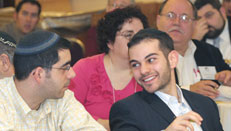 |
||||||||||||
| Weekly Parsha | ||
| Current Week | ||
| Parsha Archives | ||
| Business Ethics | ||
| Dr. Malamet Speaks Out | ||
| TiM MP3 Library | ||




A Thought for the Week with Rabbi Jay Kelman |
 We tend to divide the Bible into narrative and law. The former teach ethical and moral values while the latter instruct us on how we must conduct our life on a day to day basis. Yet it would be a mistake to see these as two separate realms. The stories, many concentrated in Sefer Breisheet , often serve as the background to the law as later promulgated in the Torah. Perhaps the most obvious example is Yaakov's struggle with the angel which serves as the background for the prohibition of eating the sciatic nerve. Examples of this phenomenon abound. Parshat Vayeishev , focusing on the sale of Joseph, brings sibling rivalry to new heights, or should we say lows. The moral lessons of this tragic story are relatively clear. They include the dangers of favouritism, a trait Yaakov no doubt learned from his parents; the power of jealousy even amongst those who would be the founders of the tribes of Israel ; the dangers of mob mentality; and the need for deception to cover up prior indiscretions. Realizing that their father would ask them the whereabouts of Joseph, the brothers devised a plan to deflect any possible suspicions away from them. "And they took Joseph's coat and they slaughtered a goat and dipped the coat in blood. They sent the long colourful coat ( kutonet ) and it was brought to their father" (38:31-32). Tragically, their deception worked-"he [Yaakov] refused to be comforted"-precluding the possibility of the brothers conducting a search for Joseph. The coat dipped in goat's blood is much more than a trivial detail of the story. Its message is so powerful that the Torah codifies the "goat" and the "coat" into law. It was the high priest who was the spiritual leader of the Jewish people. Each of the eight garments he wore was meant to bring atonement for a different sin (Erchin 16a). Amongst the garments is the kutonet , the coat, designed to bring atonement for the spilling of blood. If not for the intervention of Reuven the brothers would have actually killed Joseph. The Kohen , the person whose essence must personify peace, putting on the kutonet is reminded of the near death of our ancestor over a coat. "And one goat for a sin offering". In the Bible, special occasions are marked by a journey to Jerusalem and the bringing of sacrifices, acknowledging the Divine blessings in our life. While sacrifices were offered every day in the Temple , on holidays we were mandated to offer extra offerings, the korban Mussaf . The one constant of the korbanot Mussaf , brought on the five Biblical holidays, Rosh Chodesh and even during the dedication of the Mishkan, is a goat for a sin offering. The bringing of the goat for a sin offering seems out of place on Yom Tov, a day on which we focus on joy, not sin. While Shabbat is rooted in man's relationship to G-d acknowledging Him as the ultimate Creator, Yom Tov is rooted in the relationship between man and man. Yom Tov is a time of joy, celebrating as we do special moments of our shared history. We are bidden to come together to the Temple , to eat and celebrate. The Meshech Chochmah suggests that the reason cooking is allowed on Yom Tov is to facilitate social interaction, food being the mechanism over which people socialize. Precisely on Yom Tov when Jews come together, we need a reminder of the dangers of dissension. The sair, the goat, is that reminder. On Yom Kippur, the day designated for reconciliation both with man and then G-d, it is the goat that takes center stage. One goat is sacrificed, its blood sprinkled in the holy of holies. The second goat is thrown off the mountain. Both goats are necessary for the Yom Kippur atonement to be effective. Only by throwing away the goat of dissension can we enter the holy of holies. May we have the strength to do so soon.
|
|
|

 |
 |